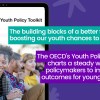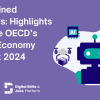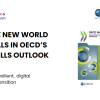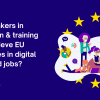What trends are shaping education in 2025? Track them with OECD!
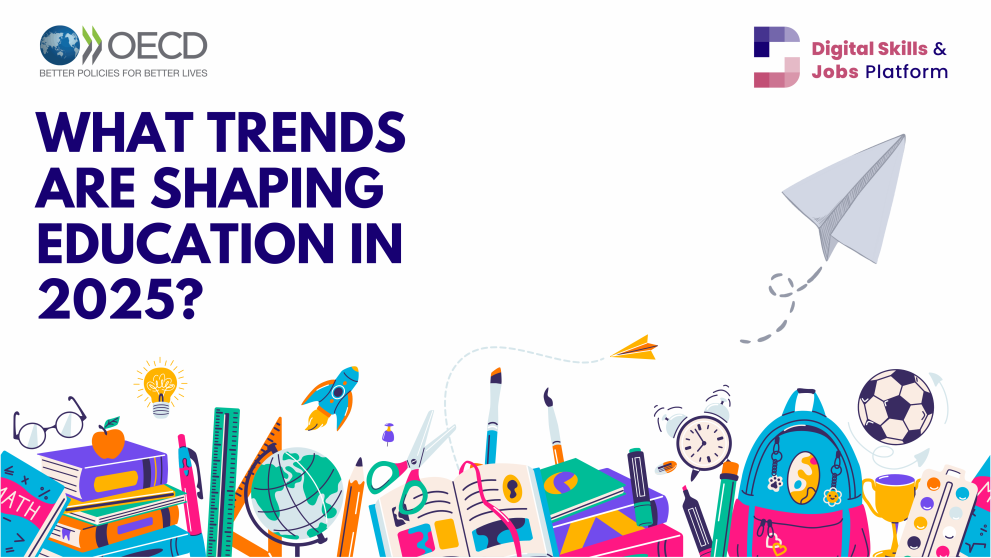
Every 3 years, the Organization for Economic Cooperation and Development (OECD) takes stock of the most dominant trends (or megatrends, as they name trends with a larger impact than the usual) shaping education in a special report. The 2025 edition of the report explores a range of themes central to education and skills, including the “explosion” of breakthrough digital technologies – think Artificial Intelligence (AI), the Internet of Things (IoT), and Virtual Reality (VR) and the extent to which they are already transforming the way we work and communicate with one another.
The report can be of interest to a large group of people, including policymakers and education professionals, administrators, teachers, academics and also students, parents and anyone that is wondering how education can address the challenges of today, whilst also preparing students for the future.
In this short but sweet article, we dive into some of the main questions the report explores to give you the highlights and main bits we gathered from the many pages of the report we read. At the same time, we’ll try to also point you to various sections on the Platform that can help you reach your learning goals, such as training opportunities on basic, intermediate and more advanced level, digital skills resources and case studies, good practice examples and reports.
Keeping up with the (digital) times
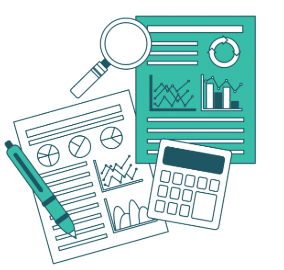 Technological advancement happens at an unprecedented pace, fast turning new ways of dealing with issues of global importance, like climate change or public health, into mainstream approaches. Yet, concerns naturally remain. For example, a recent Eurobarometer survey in 27 EU Member States and 8 other countries found that half of surveyed people believed in AI’s potential to advance scientific discoveries and the tools society has to tackle pressing issues at hand, i.e climate change, disease, etc.
Technological advancement happens at an unprecedented pace, fast turning new ways of dealing with issues of global importance, like climate change or public health, into mainstream approaches. Yet, concerns naturally remain. For example, a recent Eurobarometer survey in 27 EU Member States and 8 other countries found that half of surveyed people believed in AI’s potential to advance scientific discoveries and the tools society has to tackle pressing issues at hand, i.e climate change, disease, etc.
It also looks like the generation that follows, may not have acquired the right skillsets to be able to navigate the future in a confident, and self-aware way. In December, the OECD published the results of its PISA (in-person evaluations of key skills like literacy, numeracy, and problem-solving skills of 160.000 adults aged 16-65 in 31 different countries. Compared to the assessed levels one decade ago, literacy levels are going down in most of the surveyed countries. For those with university education, i.e tertiary level of education, the results were even more ‘striking’ – literary proficiency decreased rapidly everywhere apart from Finland.
Life on Mars? Peak into the digital future
Take your protein pills and put your helmet on: we are taking a big leap into the near future. Foresight is the ability to predict, or anticipate future developments – whether these manifest as challenges or opportunities. Foresight requires an almost intricate understanding of current trends, evidence-based approaches, and strategic thinking – this includes a long-term vision, diverse scenarios planning, and proactive decision-making, all with the aim of shaping a better future. 
Zooming in onto education, this means ensuring learners are equipped with future-proof skills that will empower them to tackle future challenges. For policymakers, teachers and education administrators this entails a proactive approach to mitigating the impact of technological disruptions, gaps and shortages in the labour market, etc. Throughout this, education curricula has to remain relevant and flexible enough to accommodate the evolving demands of the future in the context of aptitudes and skillsets.
The report looks ahead towards a range of future possibilities and trends with the potential of huge influence. If we take a look at digital skills more broadly, foresight here means anticipating the skills and competences students and workers of the future will need – all this through the narrow prism of an increasingly automated and AI and data-driven economy and society. While basic digital literacy is important (and rightly reflected in the 80% target of the Digital Decade by 2030), fostering critical thinking, flexibility, resilience, ethical AI deployment and cybersecurity readiness is just as crucial.
The increased uptake and development in the field of AI is boosting the capacity of robots working with humans across fields and in practice, this means that human-robot interaction will increase rapidly in the years to come. Since technology has an huge impact on social interactions and digital well-being, the stake in education explodes. The OECD report dives exactly into this tunnel: how can education help sustain a sense of community and foster online well-being and socio-emotional learning for the youngest and the oldest in the education circles?
Ensuring education can deliver the right set of skills
Indeed, education has its own set of unique challenges to address. Rapid technological development equals rapid transitions in the fine mechanics of skills supply and demand, raising questions on how to best align educational frameworks so they deliver real-world skills as well as the skillsets most in demand in the labour market. The OECD report seems to suggest that diversifying educational pathways and innovating teaching formats and practices is the main way forward to embrace the growing demand for high-skilled workers and lifelong learning opportunities.
From a uniquely European perspective, education is undergoing a rapid restructuring towards a future-proof map of competencies. In March 2025, the College of Commissioners adopted the Union of Skills Package, which includes a Basic Skills Action Plan and a Strategic STEM Plan. The Union of Skills Package strategy is to get all Europeans ready for the future, aiming to chart a roadmap towards an education framework that evolves hand in hand with the digital developments of the future.

The Digital Skills & Jobs Platform can help get you started on your journey to learning about tech through flexible, personalised learning pathways. The Platform’s learning path section provides an entire selection of carefully curated learning paths, such as the Cloud Computing Basic Learning Path, the VR Learning Path titled “What is real? What is virtual? In which world am I wandering?, or the more advanced learning path on AI in medicine by the xAIM project. If you’re feeling adventurous, you can also build your own path by saving training opportunities, resources, learning content and publications from all around the Platform’s sections.
Digital wellbeing: a growing area of concern
Education is the 1st step our youngsters take into curiosity and finding out how the world works, and should improve students’ competencies. However, this should not come at the expense of mental health. Recent data points to the dark and addictive side of digital media, where traditional preventative strategies do not necessarily work.

Take into account also the fact that digital technologies have practically become embedded within formal and vocational education, moulding teaching and learning practices and tools – in effect, this means that children and teenagers spend an increasingly larger part of their time online.
This comes at a cost.
Prolonged digital media use is associated with increased anxiety and depression amongst adolescents. A study in Norway found a link between social media use and high instances of depression. Another Finnish study equally associated prolonged social media use with increased anxiety after studying over 1.000 girls.
There is no denying that digital technologies have an impact on our wellbeing and mental health has become an issue of public health and an urgent concern.
The report notes that since the COVID-19 pandemic, mental health has risen sharply as a major health concern - a trend illustrated in the graph below and observed across a number of countries.
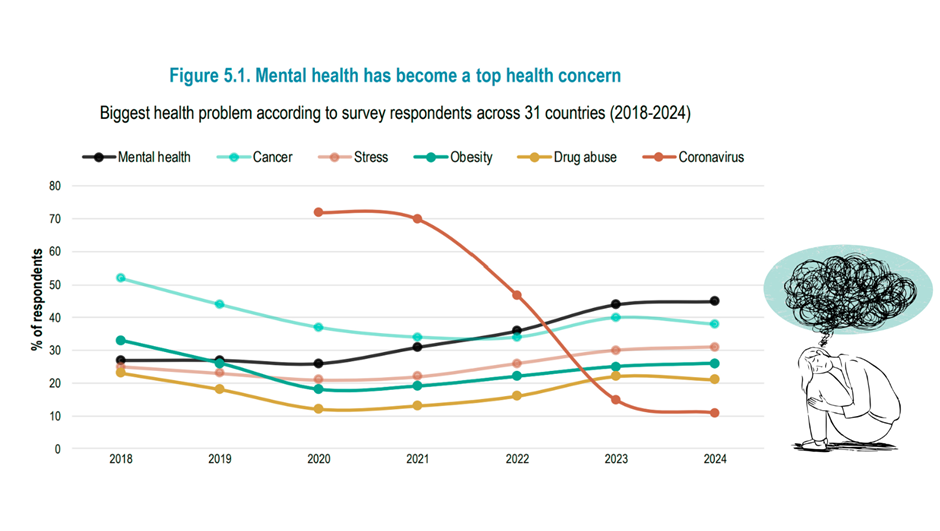
On EU level, digital wellbeing is addressed by a range of campaigns, events, and projects aiming to foster an understanding of online concerns and the impact of digital on mental health. Co-funded by the European Union, Safer Internet Centres across Europe strive to keep children and young people safe online through a range of actions and initiatives. The Commission’s strategy for a better internet for kids (BIK+), adopted on 11 May 2022, ensures children are protected, respected and empowered online in the new Digital Decade, in line with the European Digital Principles.
Explore the trends shaping education
Find the full report here and dive into the various variables impacting education right now.

